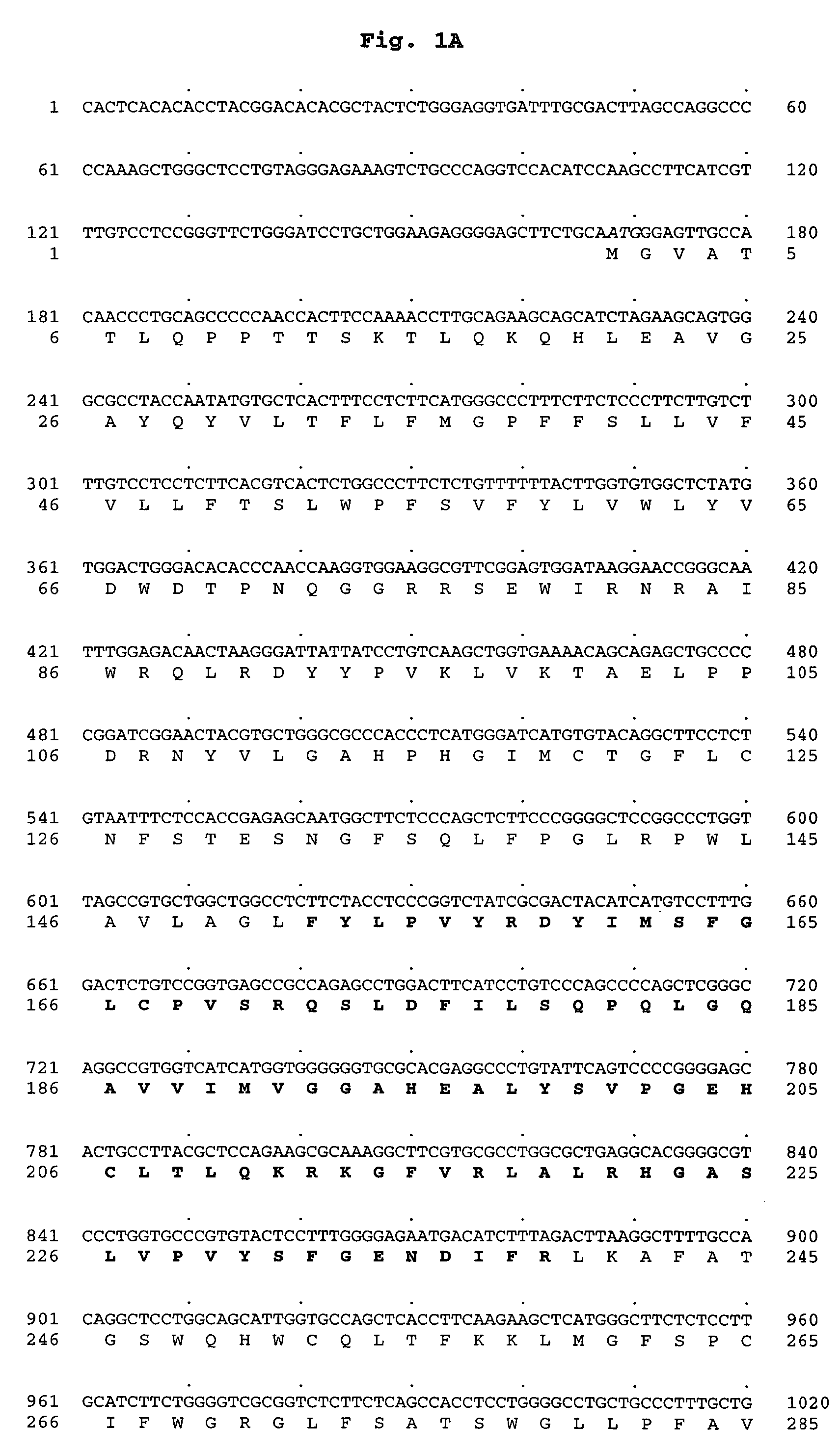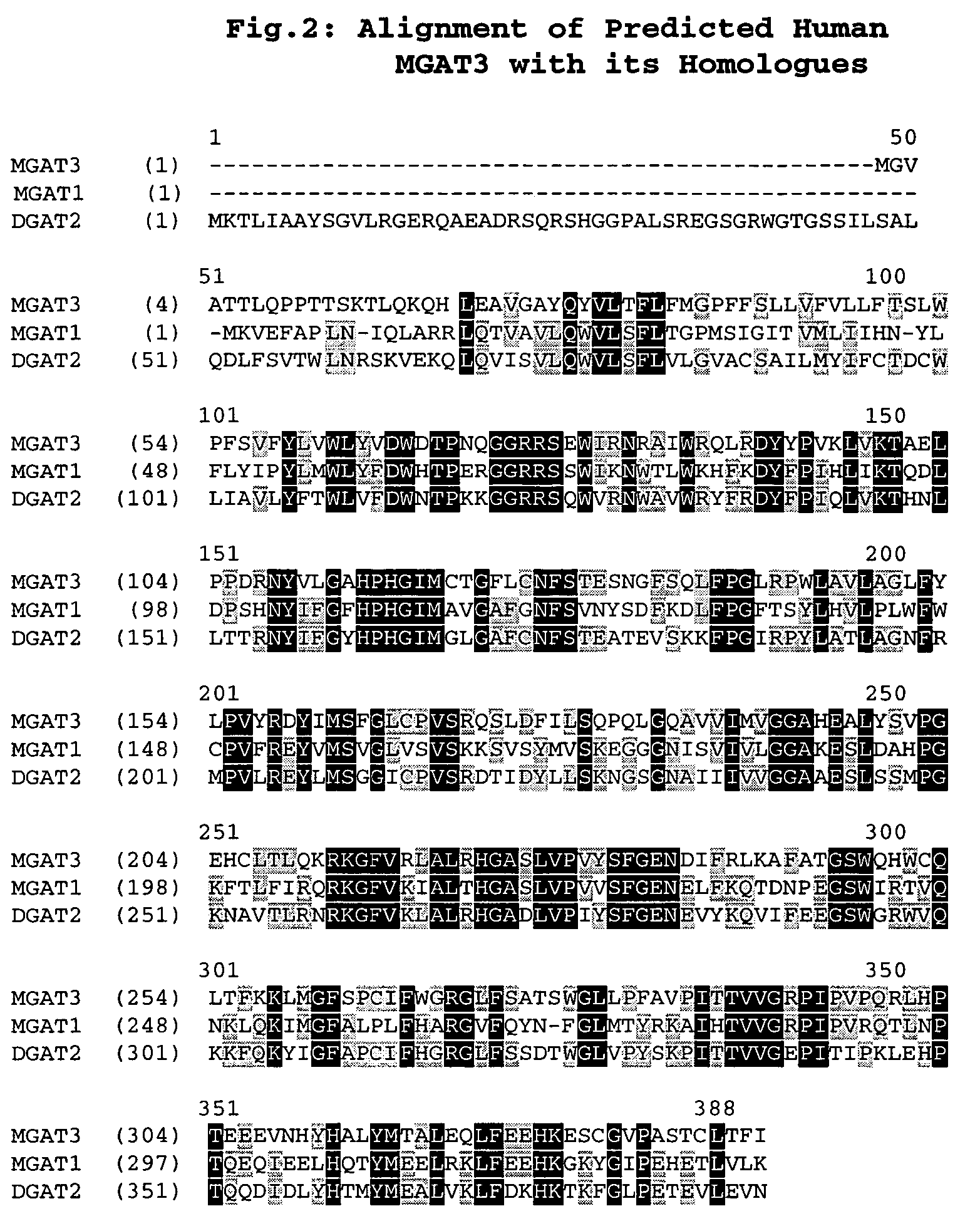Polynucleotide encoding a novel acyl coenzyme A, monoacylglycerol acyltransferase-3 (MGAT3), and uses thereof
a technology of acyl coenzyme a and polynucleotide coding, which is applied in the direction of transferases, peptide/protein ingredients, drug compositions, etc., can solve the problems that the mgat1 cannot account for the high intestinal mgat enzyme activity and undesirable side effects of faecal leakage, so as to prevent, treat, or improve a medical condition
- Summary
- Abstract
- Description
- Claims
- Application Information
AI Technical Summary
Benefits of technology
Problems solved by technology
Method used
Image
Examples
example 1
Bioinformatics and cDNA Cloning of MGAT3
[0492]Using the Materials and Methods described hereinabove, the cDNA of MGAT3 was found to have the polynucleotide sequence shown in FIG. 1 and set forth in SEQ ID NO:1 and encode a 341 amino acid protein having the sequence shown in FIG. 1 and set forth in SEQ ID NO:2.
[0493]Hydrophobicity analysis (FIG. 3) suggests that the predicted MGAT3 protein contains up to 5 potential transmembrane domains but does not contain a classic signal sequence at its NH2 terminus. MGAT3 was found to be homologous to members of the DGAT2 gene family (FIG. 2). Sequence comparison indicates that MGAT3 bears 49% identity, 60% similarity to DGAT2 and 44% identity, 51% similarity to MGAT1 respectively. Hence MGAT3 is a novel member of DGAT2 gene family (for discussion of DGAT2 gene family, see Cases, S., et al. (2001) J. Biol. Chem., 276(42):38870-6).
example 2
Expression of Recombinant Human MGAT3 in Insect Sf9 Cells
[0494]Using the Materials and Methods set forth hereinabove, recombinant human MGAT3 was expressed in insect Sf9 cells. To facilitate the detection of the MGAT3 heterologous expressed protein, a copy of FLAG epitope was fused in-frame at the NH2 terminus. Three independent strains of MGAT3 recombinant baculoviruses were established and the preliminary results showed that they all expressed the same protein. One was chosen at random for further study.
[0495]Upon infection by recombinant MGAT3 virus, Sf9 cell membrane extracts produced a band of 36 kDa on SDS-PAGE gels as detected by anti-FLAG IgG (Figure 4A, lane 2). The size of the protein is in agreement with the predicted molecular mass of human MGAT3. This band is missing in wild type virus and is different than human DGAT2 (FIG. 4, lanes 1 and 3). Aliquots of membrane extracts were used to conduct MGAT assays using radioactive [14C]oleoyl-CoA as the tracer. The TLC chromato...
example 3
Characterization of Recombinant Human MGAT3 Enzymatic Features
[0499]Using the Materials and Methods hereinabove, enzymatic features of recombinant human MGAT3 were characterized. To optimize MGAT assay conditions for recombinant human MGAT3, substrate concentrations were titrated (FIG. 6). The optimal concentration for oleoyl-CoA is 50 μM (FIG. 6A) and the optimal concentration for 2-monooleoylglycerol is 200 μM. When the concentration of 2-monooleoylglycerol increased further, the TAG synthesis decreased although DAG synthesis kept increasing until its concentration reached 1 mM.
[0500]To assess MAG stereoisomer specificity, sn-1-monooleoylglycerol (1-MAG), sn-2-monoleoylglycerol (2-MAG) and sn-3-monopalmitoylglycerol (3-MAG) were assayed (FIG. 7A). The results indicate that MGAT3 prefers 2-MAG as the substrate (compare lane 5 to lanes 2 and 8 in FIG. 7A) to synthesize DAG. Regardless of which type of MAGs were used, the amount of TAG synthesized did not change. It is possible that ...
PUM
| Property | Measurement | Unit |
|---|---|---|
| pH | aaaaa | aaaaa |
| pH | aaaaa | aaaaa |
| Tm | aaaaa | aaaaa |
Abstract
Description
Claims
Application Information
 Login to View More
Login to View More - R&D
- Intellectual Property
- Life Sciences
- Materials
- Tech Scout
- Unparalleled Data Quality
- Higher Quality Content
- 60% Fewer Hallucinations
Browse by: Latest US Patents, China's latest patents, Technical Efficacy Thesaurus, Application Domain, Technology Topic, Popular Technical Reports.
© 2025 PatSnap. All rights reserved.Legal|Privacy policy|Modern Slavery Act Transparency Statement|Sitemap|About US| Contact US: help@patsnap.com



